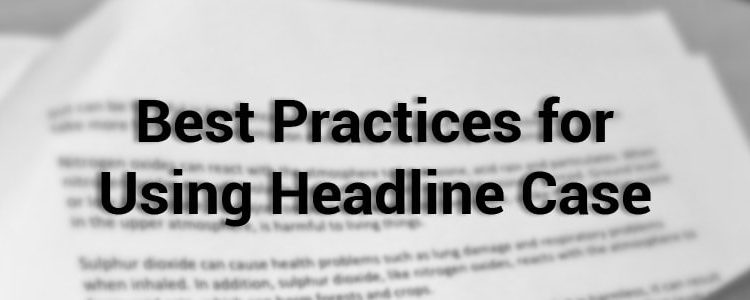Best Practices for Using Headline Case

When people read in a hurry (especially when reading online material), they mostly skim through the details and pay attention only to the headlines. Headlines are the signposts that readers rely on when navigating a piece of writing; they tell the reader, at a quick glance, where to start and which sections are more important or interesting. Academic writers often struggle with the rules of headline case, and this article will guide you through the process.
What Is Headline Case?
According to The Chicago Manual of Style (CMOS), the headline case is a practice of capitalizing words in a headline based on their speech part. The terms “headline style” and “title case” means the same thing, and some UK publications also use the term “maximum caps.”
For example: Headline case is applied in this headline. “Affordable Housing Development Stymied by Regulations.”
The alternative to headline case is “sentence case” (also called “sentence style” or, in some UK publications, “essential caps” or “minimum caps”). When applying the sentence case, the headline would read as “Affordable housing developers stymied by regulations.” As you can see, only the first letter of the first word is capitalized.
Why Is Headline Case Useful?
Headline case provides two benefits:
- Capitalization of select words visually separates the headline from the other content, which helps the reader know where an article (or a section of it) begins.
- The uppercased wording alerts the reader to the premise of the piece, which can be especially important when readers skim.
Principles of Headline Case
The Chicago Manual of Style offers several principles to help writers in applying the headline case and notes that the application is “governed mainly by emphasis and grammar.”
- Always capitalize the first and last word of the headline.
- Capitalize these speech parts: nouns, verbs, pronouns, and adverbs.
- Capitalize prepositions when they are used adjectivally or adverbially (for example: down in Turn Down and away in Look Away).
- Capitalize prepositions when they are part of a Latin phrase used adjectivally or adverbially (for example: In Vitro).
For the most part, all other words in the headline are formatted with lowercase letters. This includes the prepositions and, but, for, or, nor, and with. These same principles apply when a quote is used in a headline (for example: “They Did Not Know the Difference”: Investigations of Silver Mines Continue). Take note of the words that are often overlooked when applying headline case: Is, Are, That, and Than.
Special Cases
The following cases can call for special attention.
Hyphenated Compounds
How should you handle a hyphenated compound such as black-and-white, third-floor, or tight-lipped, especially if it appears at the beginning of the headline? First, capitalize the first element of the compound (third and tight in the examples above). Capitalize the element that follows unless it is an article (a or an), a preposition, or a coordinating conjunction (and, but, for, or, nor). In addition, you should capitalize the second element in a hyphenated number (for example: Twenty-Three).
Subtitle Capitalization
When the main text of a headline is followed by a subtitle, the first word of the subtitle is capitalized (for example: “Struggle and Sacrifice: Toward a Psychology of Grief”). If the subtitle is preceded by an em dash, the phrase is not generally considered a subtitle and, therefore, the first word does not necessarily need to be capitalized (for example: “Manhattan—the city that never sleeps”).
Double Titles
A headline that connects two related ideas with the word or rather than a colon is called a “double title.” As an example, “Parisian Culture, or The Separation of Art and Artisans” can be punctuated as “Culture; or,” or “Culture, or”—either format is acceptable as long as it is used consistently. In the first case, “The” is capitalized.
Find a few articles on your favorite online site, and look at the headlines to see if the capitalization is done correctly, is it consistent? Get into the habit of stopping at headlines to check them; the headline style then becomes easier as you practice it. If the style manual you use doesn’t provide a clear guidance, your best choice is consistency.









